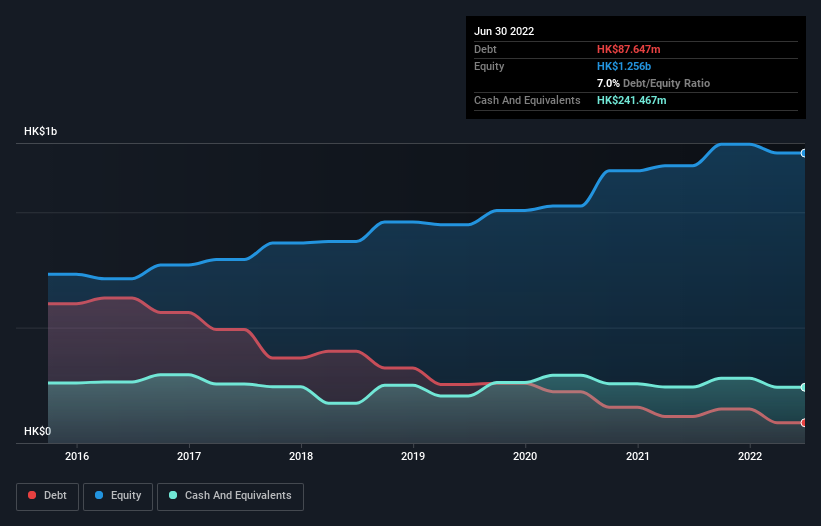Is Ka Shui International Holdings (HKG:822) Using Too Much Debt?

Some say volatility, rather than debt, is the best way to think about risk as an investor, but Warren Buffett famously said that 'Volatility is far from synonymous with risk.' When we think about how risky a company is, we always like to look at its use of debt, since debt overload can lead to ruin. We note that Ka Shui International Holdings Limited (HKG:822) does have debt on its balance sheet. But is this debt a concern to shareholders?
Why Does Debt Bring Risk?
Generally speaking, debt only becomes a real problem when a company can't easily pay it off, either by raising capital or with its own cash flow. Part and parcel of capitalism is the process of 'creative destruction' where failed businesses are mercilessly liquidated by their bankers. While that is not too common, we often do see indebted companies permanently diluting shareholders because lenders force them to raise capital at a distressed price. By replacing dilution, though, debt can be an extremely good tool for businesses that need capital to invest in growth at high rates of return. When we examine debt levels, we first consider both cash and debt levels, together.
View our latest analysis for Ka Shui International Holdings
What Is Ka Shui International Holdings's Net Debt?
You can click the graphic below for the historical numbers, but it shows that Ka Shui International Holdings had HK$87.6m of debt in June 2022, down from HK$114.9m, one year before. However, it does have HK$241.5m in cash offsetting this, leading to net cash of HK$153.8m.

How Healthy Is Ka Shui International Holdings' Balance Sheet?
Zooming in on the latest balance sheet data, we can see that Ka Shui International Holdings had liabilities of HK$428.4m due within 12 months and liabilities of HK$45.6m due beyond that. Offsetting this, it had HK$241.5m in cash and HK$389.0m in receivables that were due within 12 months. So it can boast HK$156.4m more liquid assets than total liabilities.
This surplus liquidity suggests that Ka Shui International Holdings' balance sheet could take a hit just as well as Homer Simpson's head can take a punch. With this in mind one could posit that its balance sheet means the company is able to handle some adversity. Succinctly put, Ka Shui International Holdings boasts net cash, so it's fair to say it does not have a heavy debt load!
The modesty of its debt load may become crucial for Ka Shui International Holdings if management cannot prevent a repeat of the 27% cut to EBIT over the last year. Falling earnings (if the trend continues) could eventually make even modest debt quite risky. The balance sheet is clearly the area to focus on when you are analysing debt. But it is Ka Shui International Holdings's earnings that will influence how the balance sheet holds up in the future. So if you're keen to discover more about its earnings, it might be worth checking out this graph of its long term earnings trend.
Finally, a business needs free cash flow to pay off debt; accounting profits just don't cut it. Ka Shui International Holdings may have net cash on the balance sheet, but it is still interesting to look at how well the business converts its earnings before interest and tax (EBIT) to free cash flow, because that will influence both its need for, and its capacity to manage debt. Over the most recent three years, Ka Shui International Holdings recorded free cash flow worth 76% of its EBIT, which is around normal, given free cash flow excludes interest and tax. This cold hard cash means it can reduce its debt when it wants to.
Summing Up
While it is always sensible to investigate a company's debt, in this case Ka Shui International Holdings has HK$153.8m in net cash and a decent-looking balance sheet. And it impressed us with free cash flow of HK$76m, being 76% of its EBIT. So we don't think Ka Shui International Holdings's use of debt is risky. When analysing debt levels, the balance sheet is the obvious place to start. But ultimately, every company can contain risks that exist outside of the balance sheet. To that end, you should be aware of the 2 warning signs we've spotted with Ka Shui International Holdings .
If you're interested in investing in businesses that can grow profits without the burden of debt, then check out this free list of growing businesses that have net cash on the balance sheet.
Valuation is complex, but we're here to simplify it.
Discover if Ka Shui International Holdings might be undervalued or overvalued with our detailed analysis, featuring fair value estimates, potential risks, dividends, insider trades, and its financial condition.
Access Free AnalysisHave feedback on this article? Concerned about the content? Get in touch with us directly. Alternatively, email editorial-team (at) simplywallst.com.
This article by Simply Wall St is general in nature. We provide commentary based on historical data and analyst forecasts only using an unbiased methodology and our articles are not intended to be financial advice. It does not constitute a recommendation to buy or sell any stock, and does not take account of your objectives, or your financial situation. We aim to bring you long-term focused analysis driven by fundamental data. Note that our analysis may not factor in the latest price-sensitive company announcements or qualitative material. Simply Wall St has no position in any stocks mentioned.
About SEHK:822
Ka Shui International Holdings
An investment holding company, engages in the manufacture and sale of zinc, magnesium, and aluminum alloy die casting products and components in the People’s Republic of China, the United States, and internationally.
Adequate balance sheet low.
Market Insights
Community Narratives



